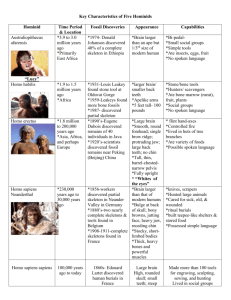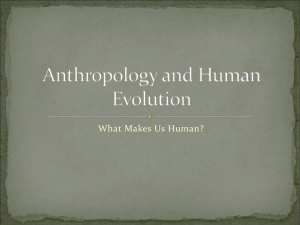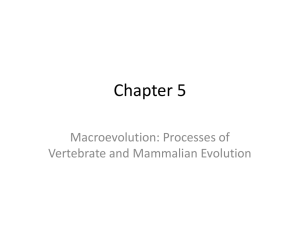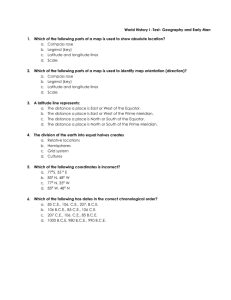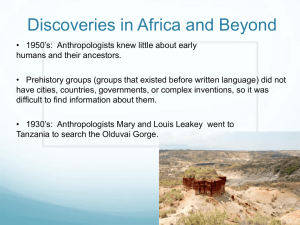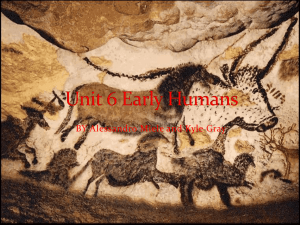Hominid Species lecture notes
advertisement
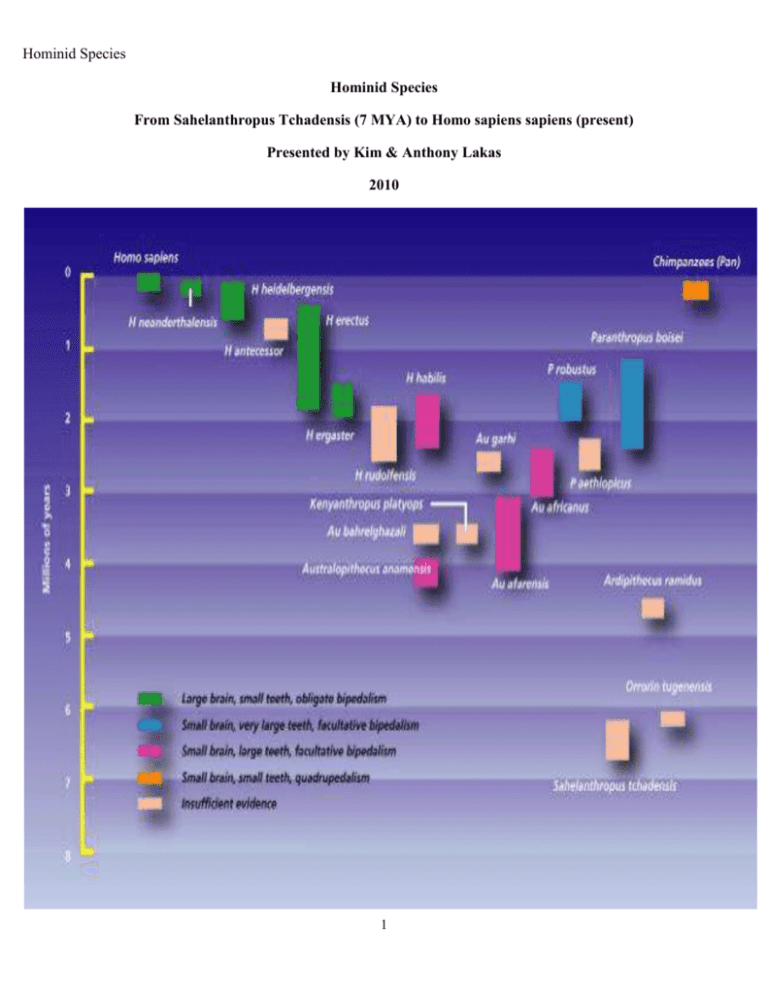
Hominid Species Hominid Species From Sahelanthropus Tchadensis (7 MYA) to Homo sapiens sapiens (present) Presented by Kim & Anthony Lakas 2010 1 Hominid Species The word "hominid" refers to members of the family of humans, __________________, which consists of all species on our side of the last common ancestor of humans and living apes. Biochemical evidence indicated that the last common ancestor of hominids and apes occurred between ___ and _____ million years ago and probably in the lower end of that range. Sahelanthropus Tchadensis 7.0 mya Chad Africa This species was named in July 2002 from fossils discovered in Chad in Central Africa. It is the oldest known hominid or near-hominid species, dated at between ___and ___million years old. This species is known from a nearly complete cranium nicknamed Toumai, and a number of fragmentary lower jaws and teeth. The skull has a very small brain size of approximately ______cc. It is not known whether it was __________. has many primitive apelike features, such as the small brain size, along with others, such as the brow ridges and small canine teeth, which are characteristic of later hominids. This mixture, along with the fact that it comes from around the time when the hominids are thought to have diverged from chimpanzees, suggests it is close to the __________ _______________ of humans and chimpanzees. Orrorin Tugenensis 6.0 mya western Kenya Africa This species was named in July 2001 from fossils discovered in western Kenya. The fossils include fragmentary arm and thigh bones, lower jaws, and teeth and were discovered in deposits that are about 6 million years old. Its finders have claimed that Orrorin was a human ancestor adapted to both bipedality and ______ _________. .A later paper (Galik et al. 2004) has found further evidence of bipedality in the fossil ___________. Ardipithecus (ramidus) kadabba 5.8 mya Ethiopia Africa First discovered by a team led by Tim White, Berhane Asfaw and Gen Suwa (1994) in 1992 and 1993 at Aramis in Ethiopia. Originally named _______________ _____________________. Was originally dated at 4.4 million years, but has since been discovered to far back as 5.8 million years. Most remains are skull fragments. Indirect evidence suggests that it was possibly bipedal. The teeth are ________________ to those of earlier apes and A. afarensis. More recently, a number of fragmentary fossils discovered between 1997 and 2001, and dating from 5.2 to 5.8 million years old, have been assigned first to a new subspecies, Ardipithecus ramidus kadabba (Haile-Selassie 2001), and then later as a new species, Ardipithecus kadabba (Haile-Selassie et al. 2004). 2 Hominid Species Australopithecus anamensis 4.2 mya Kenya Africa "Kanapoi Hominid“ first discovered by Bryan Patterson in 1965 at Kanapoi in Kenya (Patterson and Howells 1967). This is a lower left humerus. This species was named in August 1995 (Leakey et al. 1995). has a mixture of primitive features in the skull, and advanced features in the body. The teeth and jaws are very similar to those of older fossil apes. A partial _________is strong evidence of bipedality, and a lower ___________ is extremely humanlike. Australopithecus afarensis 3.9-3 mya “Lucy” Ethiopia Africa Discovered by Donald Johanson and Tom Gray in 1974 (Johanson and Edey 1981; Johanson and Taieb 1976). Its age is about 3.2 million years. Lucy was an adult female of about _____ years old, about ________% of her skeleton was found, and her pelvis, femur and tibia show her to have been bipedal. She was about 107 cm (3'6") tall (small for her species) and about 28 kg (62 lbs) in weight. Humans have much _______ _______ compared to their legs than chimpanzees do, and Lucy falls roughly in the middle. (Korey 1990) Afarensis had an apelike face with a low _____________ and brow ridges. Cranial capacity varied from about 375 to 550 cc. more humanlike teeth. The canine teeth are much smaller than those of modern apes, but larger and more _________ than those of humans. Their bones show that they were physically very strong. High degree of sexual dimorphism. Kenyanthropus platyops 3.5-3.2 mya Kenya Africa Discovered by Justus Erus, a member of a team led by Meave Leakey, in 1999 (Leakey et al. 2001, Lieberman 2001). This is a mostly complete cranium which came in two pieces: a heavily distorted skull case and a face which was much better preserved. _____________ combination of characteristics broad flat face and _________ teeth. Means "Flat faced man of Kenya". The brain size is similar to that of australopithecines. 3 Hominid Species Australopithecus africanus 3.0-2.0 mya South Africa body and brain size (ranging between 420 and 500 cc) is ____________ than afarensis. Possessed larger more human like teeth than other apes.(Johanson and Edey 1981). The shape of the jaw is now fully ______________, like that of humans, and the size of the canine teeth is further reduced compared to afarensis. “Taung child” Taung South Africa Discovered by Dart in 1924 (Dart 1925). The find consisted of a full face, teeth and jaws, and an ____________ cast of the brain. The teeth of this skull showed it to be from an child about 5 or 6 years old (it is now believed that australopithecines matured faster than humans, making it ______). The large rounded brain, canine teeth which were small and not apelike, and the position of the foramen magnum convinced Dart that this was a ____________ _____________ ____________, which he named Australopithecus africanus (African southern ape). Australopithecus garhi This species was named in April 1999 (Asfaw et al. 1999). It is known from a partial skull. The skull differs from previous australopithecine species in the combination of its features, notably the extremely _______ size of its teeth, especially the rear ones, and primitive skull morphology. Some nearby skeletal remains may belong to the same species. They show a humanlike ratio of the humerus and femur, but an __________ratio of the lower and upper arm. (Groves 1999; Culotta 1999) Australopithecus robustus 1.5-2.0 mya South Africa Had a body similar to that of africanus, but a larger and more robust skull and teeth. The massive face is ___________ _____ ______________, with no forehead and large brow ridges. Small front teeth, but massive grinding teeth in a large lower jaw. Diet would have been mostly coarse food. Most specimens have __________ ___________. The average brain size is about 530 cc. 4 Hominid Species Australopithecus boisei 2.1 – 1.1 mya Olduvai Gorge Tanzania Africa Similar to robustus, but the face and cheek teeth were larger, some molars being up to __ _____across. The brain size is very similar to robustus, about 530 cc. A few experts consider boisei and robustus to be _____________________________________. Discovered by Mary Leakey in 1959 at Olduvai Gorge in Tanzania (Leakey 1959). It is an almost complete cranium. Homo habilis 2.4 – 1.5 mya Africa The "______ _______", was so called because of evidence of tools found with its remains. It is very similar to australopithecines in many ways. The face is still primitive, but it projects less than in A. africanus. The back teeth are smaller, but still ___________________ __________________ than in modern humans. average brain size, at 650 cc, which is intermediate between ____________________ and ________________. The bulge of __________ ___________, essential for speech, is visible in one brain cast, and indicates it was possibly capable of rudimentary speech. is thought to have been about 127 cm (5'0") tall, and about 45 kg (100 lb) in weight, although females may have been smaller. Homo georgicus 1.8 mya Dmanisi Georgia Discovered in 2001 at Dmanisi in Georgia (in the ex-USSR). Estimated age is 1.8 million years. seem intermediate between H. ____________ and H. __________________ At around 600 cc, this is the smallest and most ________________ hominid skull ever discovered outside of Africa (or, at least, was until recently. Homo floresiensis is smaller) Homo erectus 1.8 mya – 300k yBP Africa, Asia, Europe Like habilis, the face has protruding jaws with large molars, _________________, thick brow ridges, and a long low skull, with a brain size varying between 750 and 1225 cc. The skeleton is more robust than those of modern humans, implying greater _______________. May have been more efficient at ________________ than modern humans, whose skeletons have had to adapt to allow for the birth of larger-brained infants (Willis 1989). Homo habilis and all the australopithecines are found only in ___________, but erectus was wide-ranging, and has been found in Africa, Asia, and Europe. There is evidence that erectus probably used _________, and their stone tools are more sophisticated than those of habilis. 5 Hominid Species Homo erectus – Peking man Zhoukoudian, China Between 1929 and 1937, 14 partial craniums, 11 lower jaws, many teeth, some skeletal bones and large numbers of stone tools were discovered in the Lower Cave at Locality 1 of the Peking Man site at Zhoukoudian, near ______________, in China. Their age is estimated to be between 500,000 and 300,000 years old. (A number of fossils of modern humans were also discovered in the Upper Cave at the same site in 1933.) Homo ergaster 1.6 mya “African erectus” Lake Turkana, Kenya, Africa Some scientists classify some African erectus specimens as belonging to a separate species, Homo ergaster, which differs from the Asian H. erectus fossils in some details of the skull (e.g. the brow ridges differ in shape, and erectus would_____ ___ _________ ____________). The adolescence’s brain size was 880 cc, and it is estimated that it would have been 910 cc at adulthood .The boy was 160 cm (5'3") tall, and estimates are that he might have been about 185 cm (6'1") as an adult. Except for the skull, the skeleton is very similar to that of modern boys. The most striking is that the holes in his vertebrae, through which the ______ _________ goes, have only about half the cross-sectional area found in modern humans. One suggested explanation for this is that the boy lacked the fine motor control we have in the thorax to control speech. (Walker and Shipman 1996). Homo sapiens (archaic) 500k -200k yBP The term covers a diverse group of skulls which have features of both _______________ and ______________. The brain size is larger than erectus and smaller than most modern humans, averaging about 1200 cc, and the skull is more _____________ than in erectus. The skeleton and teeth are usually ________ robust than erectus, but __________ robust than modern humans. Many still have large brow ridges and receding foreheads and _________. There is no clear dividing line between late erectus and archaic sapiens. Homo sapiens neanderthalensis 230k – 30k yBP Europe and Middle East First Discovered by Johann Fuhlrott in ________ in a small cave at Feldhofer in the Neander Valley in Germany. The find consisted of a skullcap, thigh bones, part of a pelvis, some ribs, and some arm and shoulder bones. The lower left arm had been broken in life, and as a result the bones of the left arm were smaller than those of the right. Fuhlrott recognized it as a primitive human, but the German establishment headed by Rudolf Virchow rejected this view, incorrectly claiming that it was a pathological modern human. (Trinkaus and Shipman 1992) In 1999, the original site was rediscovered, and more bones from the same specimen were recovered. 6 Hominid Species The average brain size is slightly larger than that of modern humans, about 1450 cc, but this is probably correlated with their greater bulk. The brain case however is_________ and _____________ than that of modern humans, with a marked bulge at the back of the skull. They had a protruding jaw and receding forehead. The chin was usually _________. The midfacial area also _____________, a feature that is not found in erectus or sapiens and may be an adaptation to cold. Neandertals mostly lived in cold climates, and their body proportions are similar to those of modern cold-adapted peoples: short and solid, with short limbs. Men averaged about 168 cm (5'6") in height. Their bones are ______ and ________, and show signs of powerful muscle attachments. Neandertals would have been extraordinarily strong by modern standards. A large number of tools and weapons have been found, more advanced than those of Homo erectus. First people known to have ________ _______ __________, with the oldest known ________ site being about 100,000 years old. They are found throughout Europe and the Middle East.(Trinkaus and Shipman 1992; Trinkaus and Howells 1979; Gore 1996) Homo floresiensis 95k -13k yBP Indonesia a species of _________ human discovered in the Indonesian island of Flores in 2003 (Brown et al. 2004, Morwood et al. 2004, Lahr and Foley 2004). Only about _____ _________ in height and fully bipedal, with a very small brain size of 417cc. The skull has human-like teeth with a receding forehead and no chin. Used stone tools and fire, and hunted _________ __________, Komodo dragons, and the giant rats found on Flores. Its discoverers believe that floresiensis is a _______ form of Homo erectus - it is not uncommon for _______ forms of large mammals to evolve on islands. Homo sapiens sapiens (Cro-Magnon) 35K-10K yBP Discovered by workmen in _______ at Cro-Magnon, in the village of Les Eyzies in France. The site yielded 5 skeletons (3 adult males, an adult female, and a child) which had been buried there, along with stone tools, carved reindeer antlers, ivory pendants, and shells. The Cro-Magnons lived in ___________. They are virtually identical to modern man, being tall and muscular and slightly more robust on average than most modern humans. They were skilled hunters, toolmakers and artists famous for the cave art at places such as ___________, Chauvet, and Altamira. 7 Hominid Species The skull at left is Cro-Magnon 1, is a male with a brain size of 1600 cc, some 200 cc larger than the average modern human. Homo sapiens sapiens (Modern) 195k years ago – Present Modern humans have an average brain size of about 1350 cc. The forehead rises sharply, eyebrow ridges are very small or more usually absent, the chin is prominent, and the skeleton is very gracile. About 40,000 years ago, with the appearance of the Cro-Magnon culture, tool kits started becoming markedly more sophisticated, using a wider variety of raw materials such as bone and antler, and containing new implements for making clothing, engraving and sculpting. Fine artwork, in the form of decorated tools, beads, ivory carvings of humans and animals, clay figurines, musical instruments, and spectacular cave paintings appeared over the next 20,000 years. (Leakey 1994) Even within the last 100,000 years, the long-term trends towards smaller molars and decreased robustness can be discerned. The face, jaw and teeth of Mesolithic humans (about 10,000 years ago) are about 10% more robust than ours. Upper Paleolithic humans (about 30,000 years ago) are about 20 to 30% more robust than the modern condition in Europe and Asia. These are considered modern humans, although they are sometimes termed "primitive". Interestingly, some modern humans (aboriginal Australians) have tooth sizes more typical of archaic sapiens. The smallest tooth sizes are found in those areas where food-processing techniques have been used for the longest time. This is a probable example of natural selection which has occurred within the last 10,000 years (Brace 1983). Summary Putting it all together! There are a number of clear trends (which were neither continuous nor uniform) from early australopithecines to recent humans: increasing brain size, increasing body size, increasing use of and sophistication in tools, decreasing tooth size, decreasing skeletal robustness. There are no clear dividing lines between some of the later gracile australopithecines and some of the early Homo, between erectus and archaic sapiens, or archaic sapiens and modern sapiens. Despite this, there is little consensus on what our family tree is. Everyone accepts that the robust australopithecines (aethiopicus, robustus and boisei) are not ancestral to us, being a side branch that left no descendants. Whether H. habilis is descended from A. afarensis, africanus, both of them, or neither of them, is still a matter of debate. It is possible that none of the known australopithecines is our ancestor. A number of new genera and species have been discovered within the last decade (Ar. ramidus, Au. amanensis, Au. bahrelghazali, Au. garhi, Orrorin, Kenyanthropus, Sahelanthropus) and no consensus has yet formed on how they are related to each other or to humans. It is generally accepted that Homo erectus is descended from Homo habilis (or, at least, some of the fossils often assigned to habilis), but the relationship between erectus, sapiens and the Neandertals is still unclear. Neandertal affinities can be detected in some specimens of both archaic and modern sapiens. 8 Hominid Species 9

